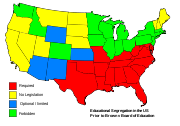
Coit v. Green
Encyclopedia

Private school
Private schools, also known as independent schools or nonstate schools, are not administered by local, state or national governments; thus, they retain the right to select their students and are funded in whole or in part by charging their students' tuition, rather than relying on mandatory...
which practiced racial discrimination could not be eligible for a tax exemption
Tax exemption
Various tax systems grant a tax exemption to certain organizations, persons, income, property or other items taxable under the system. Tax exemption may also refer to a personal allowance or specific monetary exemption which may be claimed by an individual to reduce taxable income under some...
.
Historical background
Several cases floundered after the landmark desegregation cases. AmericanUnited States
The United States of America is a federal constitutional republic comprising fifty states and a federal district...
ideas of free labor at the demise of the Lochner era
Lochner era
The Lochner era is a period in American legal history in which the Supreme Court of the United States tended to strike down laws held to be infringing on economic liberty or private contract rights, and takes its name from a 1905 case, Lochner v. New York. The beginning of the period is usually...
caused federal lawyers in the Civil Rights Section to attempt to create a labor-infused civil rights framework, which the "all deliberate speed" of Brown v. Board of Education stood upon as a means to progress constitutional law that swamped Plessy v. Ferguson. Coit v. Green developed the framework for later cases such as Prince Edward School Foundation v. U.S., and Doe and Rabago v. Kamehameha Schools/Bernice Pauahi Bishop Estate, et al.. All of these cases involve a post-civil war lawsuit banning racial exclusion in public buildings and facilities, as well as contracts, known as the Black Codes.
It is notable that U.S. Supreme Court Justice Hugo Lafayette Black, a former member of the Ku Klux Klan
Ku Klux Klan
Ku Klux Klan, often abbreviated KKK and informally known as the Klan, is the name of three distinct past and present far-right organizations in the United States, which have advocated extremist reactionary currents such as white supremacy, white nationalism, and anti-immigration, historically...
resigned from the Supreme Court Friday, September 17, 1971 after a debilitating stroke. He died eight days later. He was replaced by Warren E. Burger
Warren E. Burger
Warren Earl Burger was the 15th Chief Justice of the United States from 1969 to 1986. Although Burger had conservative leanings, the U.S...
whereby this particular session of Burger court extended from Saturday, September 18, 1971 to January 6, 1972 when new Justices were appointed; thus dismantling the Hugo Black
Hugo Black
Hugo Lafayette Black was an American politician and jurist. A member of the Democratic Party, Black represented Alabama in the United States Senate from 1927 to 1937, and served as an Associate Justice of the Supreme Court of the United States from 1937 to 1971. Black was nominated to the Supreme...
formed Warren Court
Warren Court
The Warren Court refers to the Supreme Court of the United States between 1953 and 1969, when Earl Warren served as Chief Justice. Warren led a liberal majority that used judicial power in dramatic fashion, to the consternation of conservative opponents...
as John Marshall Harlan II
John Marshall Harlan II
John Marshall Harlan was an American jurist who served as an Associate Justice of the Supreme Court from 1955 to 1971. His namesake was his grandfather John Marshall Harlan, another associate justice who served from 1877 to 1911.Harlan was a student at Upper Canada College and Appleby College and...
disbanded, and Rehnquist and Justice Powell joined.
Coit v. Green became the foundation for later finding that state tax exemptions to private charitable foundation were sufficient to establish state action under the Equal protection clause
Equal Protection Clause
The Equal Protection Clause, part of the Fourteenth Amendment to the United States Constitution, provides that "no state shall ... deny to any person within its jurisdiction the equal protection of the laws"...
of the Fourteenth Amendment
Fourteenth Amendment to the United States Constitution
The Fourteenth Amendment to the United States Constitution was adopted on July 9, 1868, as one of the Reconstruction Amendments.Its Citizenship Clause provides a broad definition of citizenship that overruled the Dred Scott v...
.
Summary of findings
In Green v. Connally, the court declared that neither IRC 501(c)(3) nor IRC 170 provided for tax-exempt status or deductible contributions to any organization operating a private school that discriminates in admissions on the basis of race. Since this time, if a school has adopted and announced a racially non-discriminatory admissions policy and has not taken any overt action to discriminate in admissions, the Service concludes that the school has a racially non-discriminatory admissions policy. The U.S. Supreme Court, however, specifically did not rule on the hypothetical possibility of a school which discriminated against minorities for religious reasons.In the interim, the IRS took steps to implement the nondiscrimination requirement including Revenue Ruling 71-447, 1971-2 C.B. 230, Revenue Procedure 72-54, 1972-2 C.B. 834, Revenue Procedure 75-50, 1975-2 C.B. 587, and Revenue Ruling 75-231, 1975-1 C.B. 158. Without comment, the Supreme Court affirmed the judgment of the United States District Court for the District of Columbia at the end of 1971 for the families in this case.

